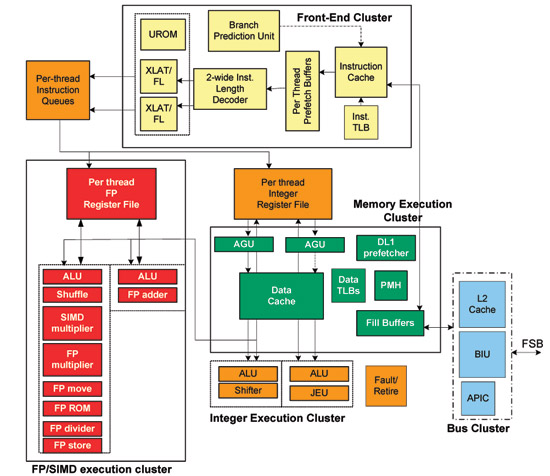NVIDIA Introduces dual Cortex A9 based Tegra 2
by Anand Lal Shimpi on January 7, 2010 2:00 PM EST- Posted in
- Smartphones
- Mobile
Atom vs. Cortex A9
With Atom Intel adopted an in-order architecture to save power. With Cortex A9, ARM went out of order to improve performance. Despite the fundamental difference, Atom and ARM's Cortex A9 appear similar from a high level.
Atom has two instruction decoders at the front end, as does the A9. The dual decoders feed an instruction queue that can dispatch out of order:

Intel's Atom Architecture
Both architectures appear to have a unified instruction queue that feed four dispatch ports. Atom has two ports that feed AGUs and/or ALUs, and two ports for the FPU (one for SSE and one for FP ops). A9 has two ALU ports, one FPU/NEON port and one AGU port.

Single-core ARM Cortex A9
Atom's advantage here is Hyper Threading as two threads get to share its execution resources simultaneously. Cortex A9's advantage is in a shallower pipeline and out of order execution. Both promote higher IPC but go about it in very different ways. If ARM can get clock speeds high enough they may actually have a higher performance option.
Final Words
Honestly, Tegra 2 is one of the most exciting things I've seen at CES - but it's mostly because of its dual Cortex A9 cores. While I'm excited about improving 3D graphics performance on tablets and smartphones, I believe general purpose performance needs improvement. ARM's Cortex A9 provides that improvement.
The days of me pestering smartphone vendors to drop ARM11 and embrace Cortex A8 are over. It's all about A9 now. NVIDIA delivers one solution with Tegra 2, but TI's OMAP 4 will also ship with a pair of A9s.
The big unknown continues to be actual, comparable power consumption. We're also lacking measurable graphics performance compared to the PowerVR SGX cores (particularly the SGX 540).
If NVIDIA is to be believed, then Tegra 2 is the SoC to get. I suspect that's being somewhat optimistic. But rest assured that if you're buying a smartphone in 2010, it's not Snapdragon that you want but something based on Cortex A9. NVIDIA is a viable option there and we'll have to wait until Mobile World Congress next month to see if there are any promising designs based on Tegra 2.
And just in case I wasn't clear earlier, we will see the first Tegra based Android phone in 2010. I just hope it's good.










55 Comments
View All Comments
Genx87 - Friday, January 8, 2010 - link
The fusion of the phone and entertainment is heading towards gaming on our phones. At the end of the day it is very possible we ditch laptops and home computers for a phone that does it all.Taft12 - Thursday, January 7, 2010 - link
You sure did beat the crap out of that strawman!I'll take a Tegra for playing a decent looking 3D game on a smartphone thank you very much!
sprockkets - Thursday, January 7, 2010 - link
They already exist and are better than what nVidia offers, thank YOU very much!!!tomaccogoats - Thursday, January 7, 2010 - link
Though this article has me wondering if Nvidia has enough ppl to spread around, I honestly don't know. If they have to same manpower as ati (once again i have absolutely no clue) then wouldn't ati start gaining the upper hand in terms of desktop graphic solutions?Spoelie - Friday, January 8, 2010 - link
NVIDIA is a much larger company than ATi was before AMD's acquisition, something to the tune of over double the engineers (in 2006...)You can't really compare the 2 at this moment anymore though
Taft12 - Thursday, January 7, 2010 - link
Enough people to spread around? WTF are you talking about? Companies have multiple core competencies and engineers don't get moved from desktop graphics projects to Tegra.When they purchased PortalPlayer in 2007 for $350M, what they were buying was not just IP, but SoC expertise of the employees that surely was/is a huge part of this product.
janiszalitis - Thursday, January 7, 2010 - link
Where have you been?ATI is totally blasting Nvidia out of desktop graphics market!
If NVidia wants to retain reasonable share there, they have to release something good sometime soon.
tomaccogoats - Friday, January 8, 2010 - link
I just meant that given the same amount of manpower at each company, nvidia seems to spreading their business to more markets than ati, which seems to be focusing more on desktop solutionsBoushh - Thursday, January 7, 2010 - link
Desktop graphics are not that important any more. Already more than 50% of the market is based on laptops. And this will only grow.What Nvidia is doing is finding other markets it can make products for. Because building a company on a single product line is a problem if that market disappears.
Nvidia is hoping that products like the Tegra and Tesla will eventualy take over the profit they previously got from desktop graphics.
And that's not to late. Already CPU's are here (Westmere) that have on die GPU's. That will be intergrated GPU's in a year or so. That means that Intel can (and AMD when they get there) provide more than 90% of the needs for graphics on PCs or laptops. That leaves only a nice market for powerfull graphics.
So there will be a market for GPUs in the future. But the real money will be in the netbook, tablet and smartphone market.
tomaccogoats - Thursday, January 7, 2010 - link
If it means longer battery life than i'm a happy camper :)